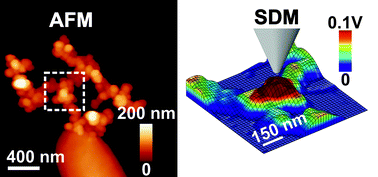Electrical properties of outer membrane extensions from Shewanella oneidensis MR-1†
Abstract
Shewanella oneidensis MR-1 is a metal-reducing bacterium that is able to exchange electrons with solid-phase minerals outside the cell. These bacterial cells can produce outer membrane extensions (OMEs) that are tens of nanometers wide and several microns long. The capability of these OMEs to transport electrons is currently under investigation. Tubular chemically fixed OMEs from S. oneidensis have shown good dc conducting properties when measured in an air environment. However, no direct demonstration of the conductivity of the more common bubble-like OMEs has been provided yet, due to the inherent difficulties in measuring it. In the present work, we measured the electrical properties of bubble-like OMEs in a dry air environment by Scanning Dielectric Microscopy (SDM) in force detection mode. We found that at the frequency of the measurements (∼2 kHz), OMEs show an insulating behavior, with an equivalent homogeneous dielectric constant εOME = 3.7 ± 0.7 and no dephasing between the applied ac voltage and the measured ac electric force. The dielectric constant measured for the OMEs is comparable to that obtained for insulating supramolecular protein structures (εprotein = 3–4), pointing towards a rich protein composition of the OMEs, probably coming from the periplasm. Based on the detection sensitivity of the measuring instrument, the upper limit for the ac longitudinal conductivity of bubble-like OMEs in a dry air environment has been set to σOME,ac < 10−5 S m−1, a value several orders of magnitude smaller than the dc conductivity measured in tubular chemically fixed OMEs. The lack of conductivity of bubble-like OMEs can be attributed to the relatively large separation between cytochromes in these larger OMEs and to the suppression of cytochrome mobility due to the dry environmental conditions.



 Please wait while we load your content...
Please wait while we load your content...